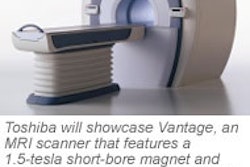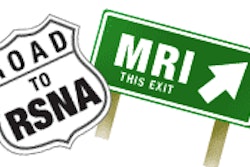CHICAGO - MRI continues to prove its mettle for assessing breast cancer in women at high risk for the disease, according to two European studies presented at the RSNA meeting on Sunday.
First, Dr. Christopher Riedl from the University of Vienna shared initial results from the Austrian National Screening Trial. The patients for this prospective study were recruited from nine imaging centers and 13 genetic counseling centers across the country. Only patients who carried the BRCA 1 or 2 genetic mutation were included; patients with a family history of breast cancer, but no known BRCA status, were excluded.
One-hundred and ninety-two women were enrolled. The trial protocol consisted of a clinical exam, palpation ultrasound every six months with mammography, and MR at 12 months. The patients were between the eighth and twelfth day of their menstrual cycles. MR was performed on either a 1-tesla or a 1.5-tesla MR unit. The imaging protocol consisted of sagittal T2-weighted images, TSE or STIR.
Riedl presented results from 90 women and 148 MR studies. The final analysis on breast carcinoma size and stage covered 80 asymptomatic and 11 symptomatic patients. Open biopsy in the 11 symptomatic patients revealed four cancers, all of which were larger than 2 cm and node-positive.
In the 80 patients with at least one screening exam, eight open biopsies revealed five breast carcinomas and three benign results. MR was able to detect all five of these cancers, Riedl said, while only two of the five were uncovered by mammography and ultrasound. The majority of the carcinomas (80%) were less than 1 cm while 60% were node-negative.
"MRI appears to be superior to mammography and ultrasound for screening of BRCA 1 and 2 mutation carriers. MRI seems to help early diagnosis in this patient population. We recommend MR for these mutations carriers," said Riedl.
Riedl added that next phase of the study will focus on the women who were excluded from the first arm of the trial, those with a familial history of breast cancer but no documented BRCA mutations. These updated results will be presented at the 2004 European Congress of Radiology in Vienna, Riedl said.
Picking up where Riedl and colleagues left off was Dr. Francesco Sardanelli from the Instituto Policlinico San Donato in Milan, Italy. Sardanelli and co-investigators tested breast MR in high-risk women who were either BRCA 1 or 2 carriers or had a strong family history.
Including the latter women was important in order to address two problems associated with genetic testing for BRCA, Sardanelli explained. BRCA mutations account for only 50% of inherited cancers. Second, many women refuse to undergo genetic testing because of the psychological stress involved.
This study was done at 13 centers around Italy and was managed by the Instituto Superiore di Sanita, a division of the national health ministry, Sardanelli said. Eligible participants were women 25 years or older who were either BRCA carriers, had a first-degree relative who was a carrier, had a strong family history, or a personal history of breast cancer. Up to March 2003, 153 women were included, with 92 BRCA 1 carriers, 20 BRCA 2 carriers, and 41 with either a family history or a first-degree carrier relation.
MR imaging was done during the second week of the menstrual cycle on either 1-tesla or 1.5-tesla units. The protocol included 3-D, T1-weighted gradient echo dynamic imaging. Mammography and ultrasound exams were also performed.
According to the results, 66 of the 153 women underwent both the first and second round of annual screening with all three modalities. Ten patients were found to have breast cancer during the first round and two more were diagnosed during the second round of screening, for a global incidence of 7.8%.
In total, MRI found 11 of 12 cancers with four false-positives. Of the dozen cancers, 67% were detected only by MRI. The cancers ranged in size from 5 mm-18 mm. In women with a family history, the incidence rate of breast cancer was 19.2%; in women with a previous personal history of breast cancer, the incidence was 11.7%.
The group concluded that women with a strong family history of breast cancer would benefit from annual MR screening, independent of genetic testing.
Session moderator Dr. Carol Lee asked both Riedl and Sardanelli how they handled lesions that were deemed probably benign on MRI. Riedl said his group performed follow-up imaging at three months, although that policy was initially met with resistance by his hospital’s surgeons and gynecologists. Sardanelli also said the patient was recalled for a second MR exam.
While the second exam was feasible for the purposes of the study, it is a costly prospect in the real world. Sardanelli estimated that an MR scan in Italy costs ten times as much as a mammogram. However, because of the higher sensitivity of MR for detecting breast lesions in these particular patients, the cost may be lower than mammography in the long run, he said.
By Shalmali Pal
AuntMinnie.com staff writer
November 30, 2003
Related Reading
Four-tesla MRS tumor measurement cuts out unnecessary breast biopsies, November 25, 2003
MDCT detects breast tumors missed by mammography and US, September 17, 2003
Contrast digital mammography helps visualize cancer in dense breasts, August 29, 2003
MRI useful in detecting missed breast cancer in high-risk women, June 25, 2003
Copyright © 2003 AuntMinnie.com



















